The great state of Mississippi has more wondrous natural beauty to admire than its famous marshes and magnolias. When exploring its many hills, rivers, and plains, you can’t help but marvel at the diverse plants that also call Mississippi home. But among the pretty flowers and showy shrubs are plants full of poison, too. These highly toxic plants could cause mild poisoning symptoms like a skin rash or severe conditions that could be fatal. So keep reading to discover eight poisonous plants in Mississippi you should avoid. You might be surprised to learn which dangerous plants in the US are also a threat in the Magnolia State.
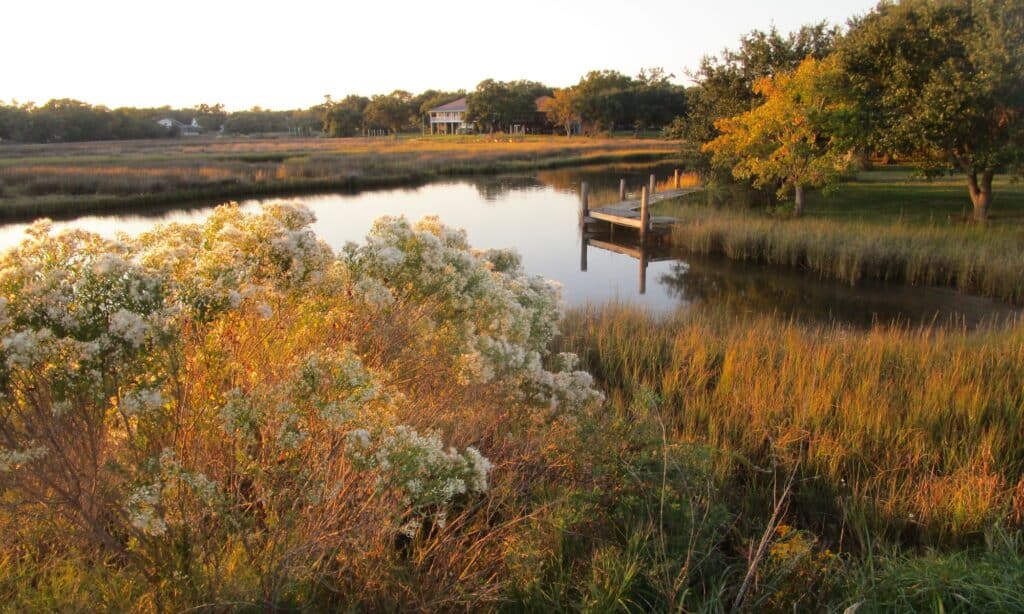
Mississippi is home to many wondrous plant species, including ones that are poisonous.
©iStock.com/MICMOABLE
1. Crown Vetch (Securigera varia)
The crown vetch produces beautiful pink and white flowers with a lovely smell. Unfortunately, it’s also a highly toxic, invasive, and noxious weed. This poisonous plant in Mississippi is a creeping herbaceous perennial with 15-25 leaflets on stems growing 2-6 feet long. It also produces long, finger-shaped seed pods and has an aggressive root system. So with its many seeds and aggressive roots, this poisonous plant is hard to control.
Crown vetch habitats include sunny open fields, roadsides, waste areas, and disturbed areas with sandy soil.
Toxins and Poisoning Symptoms
The toxins in crown vetch plants include beta-Nitroproprionic (or 3-Nitroproprionic), a form of mycotoxin. Ingesting any part of the crown vetch plant could cause symptoms like diarrhea, vomiting, an irregular heartbeat, involuntary muscle contractions, cardiac arrest, weakness, coma, and death.
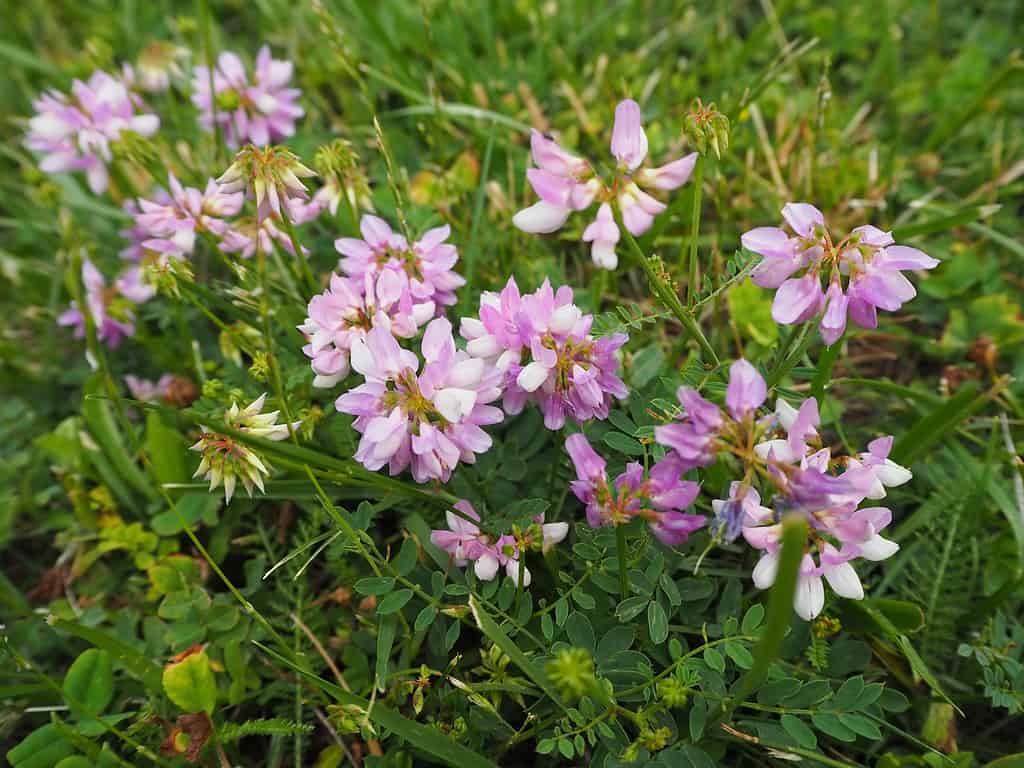
Crown vetch plants are invasive, highly poisonous, and could cause life-threatening symptoms if ingested.
©mirti/Shutterstock.com
2. Poison Ivy (Toxicodendron radicans)
The notorious poison ivy plant is a climbing vine or shrub with leaves that grow in three leaflet patterns. In addition, the leaves of this poisonous plant in Mississippi are often glossy with serrated edges, but the shapes and textures might vary. In summer, poison ivy sometimes produces small greenish-white flowers, followed by cream-colored berries. Also, this plant can trail or climb up to 75 feet in its ideal habitats, like sunny, wooded areas.
Toxins and Poisoning Symptoms
Poison ivy produces an oil called urushiol, which can cause itchy, red rashes and blisters on the skin. Be careful not to transfer this toxin from your hands to the mucus membranes of your nose, mouth, and eyes.
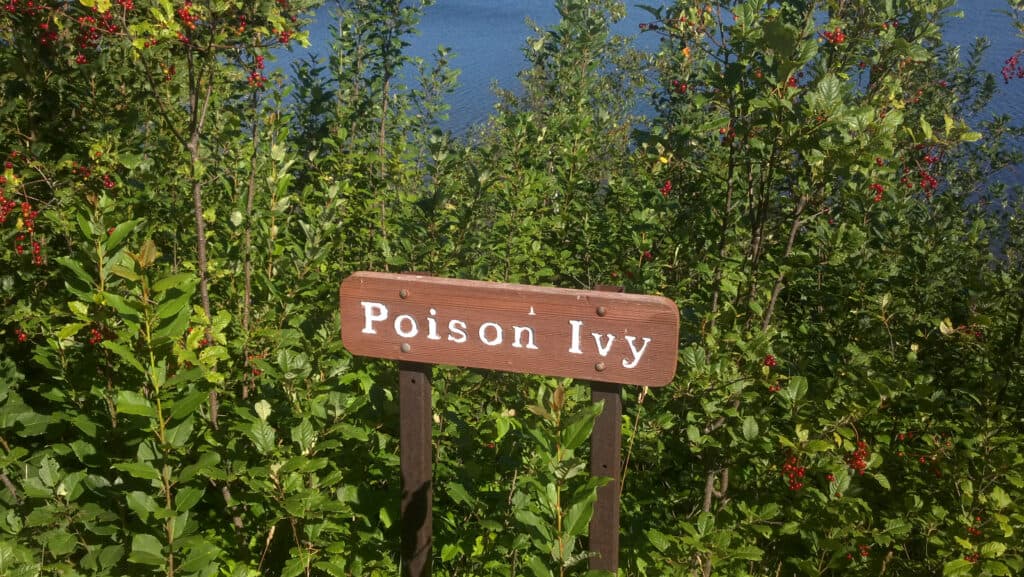
Poison ivy is one of the most common poisonous plants in Mississippi you should avoid.
©Tim R7/Shutterstock.com
3. White Snakeroot (Ageratina altissima)
The white snakeroot plant is an herbaceous perennial with tiny clusters of white flowers. It also has toothed leaves with a rough texture. White snakeroot commonly grows near streams and wooded areas, but this Mississippi poisonous plant is a big problem in pastures.
Livestock like cattle and sheep may ingest parts of the white snakeroot plant when it is accidentally mixed with their feed. In addition, the toxins that enter their bodies might pass through their milk to their young.
It’s rare for humans to develop white snakeroot poisoning from contaminated cow’s milk. However, it’s possible by ingesting unpasteurized milk from an infected animal.
Toxins and Poisoning Symptoms
A chemical compound called tremetone is the primary toxin in white snakeroot plants. Ingesting tremetone causes tremors when passed through animal milk. Also known as “milk sickness,” tremetone poisoning leads to additional symptoms like weakness, vomiting, and loss of appetite. Severe cases could result in respiratory failure and liver damage.

The white snakeroot’s toxins can pass from one animal to another by ingesting the infected animal’s milk.
©Nahhana/Shutterstock.com
4. Leafy Spurge (Euphorbia esula)
The leafy spurge is one of the poisonous plants in Mississippi that’s also invasive. This 1-3 foot tall shrub features two types of blueish-green leaves. Its scalelike leaves grow near the bottom, and its linear leaves grow near the top of the plant. Leafy spurge also produces umbels (umbrella-shaped clusters) with tiny greenish-yellow flowers.
Typical habitats for leafy spurge include pastures, abandoned fields, and wet soil areas like swamps and bogs.
Toxins and Poisoning Symptoms
Leafy spurge produces a milky sap that contains pro-inflammatory diterpenes. Due to the toxicity of this sap, touching leafy spurge plants with bare skin could cause a severe, painful rash with blisters. Mississippi animals that brush up against this plant may lose their hair and develop blisters at the points of contact.
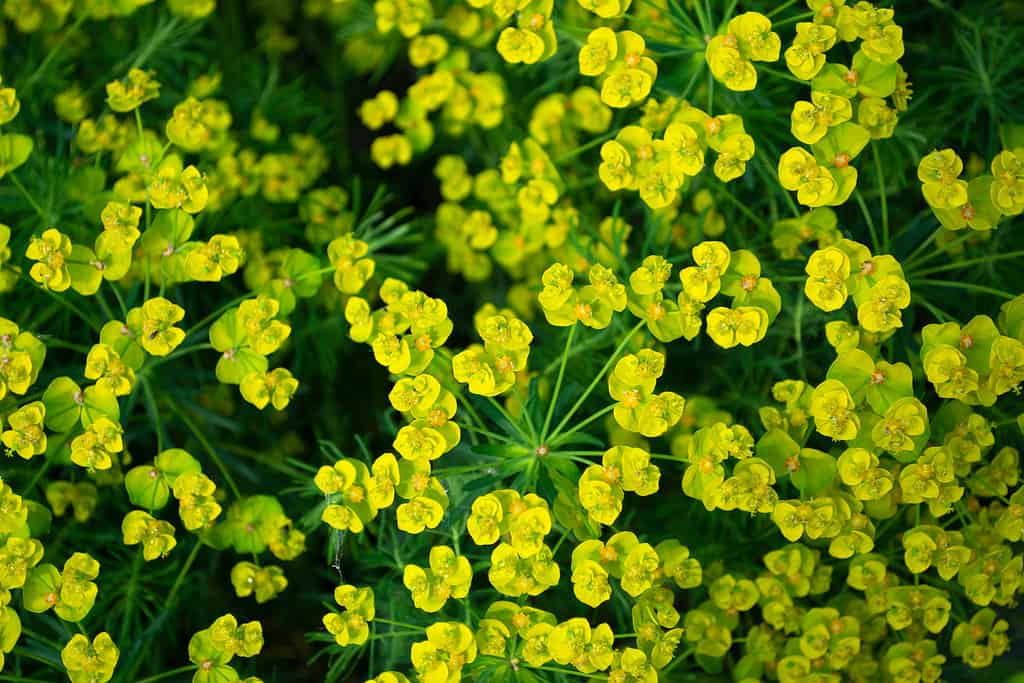
Don’t touch leafy spurge plants with bare skin due to the skin-burning toxins it produces.
©Oksana Shevchenko/Shutterstock.com
5. American Pokeweed (Phytolacca americana)
The American pokeweed plant is a large perennial herb with smooth, lance-shaped leaves and clusters of small white flowers that develop into dark purple berries. In addition, his plant has noticeably dark pink stems holding the fruit in place. But don’t eat these poisonous raw berries! In fact, eating any part of the pokeweed plant could result in severe plant poisoning symptoms.
Pokeweed grows an average of 5-10 feet tall and thrives in fields, woodlands, roadsides, and fence rows.
Toxins and Poisoning Symptoms
American pokeweed contains saponin, phytolacca toxin, and mitogen content that make it a poisonous plant. Touching pokeweed could cause a skin rash with blisters. The symptoms of ingesting any part of the American pokeweed include nausea, vomiting, diarrhea, stomach cramps, muscle spasms, difficulty breathing, convulsions, and unconsciousness.
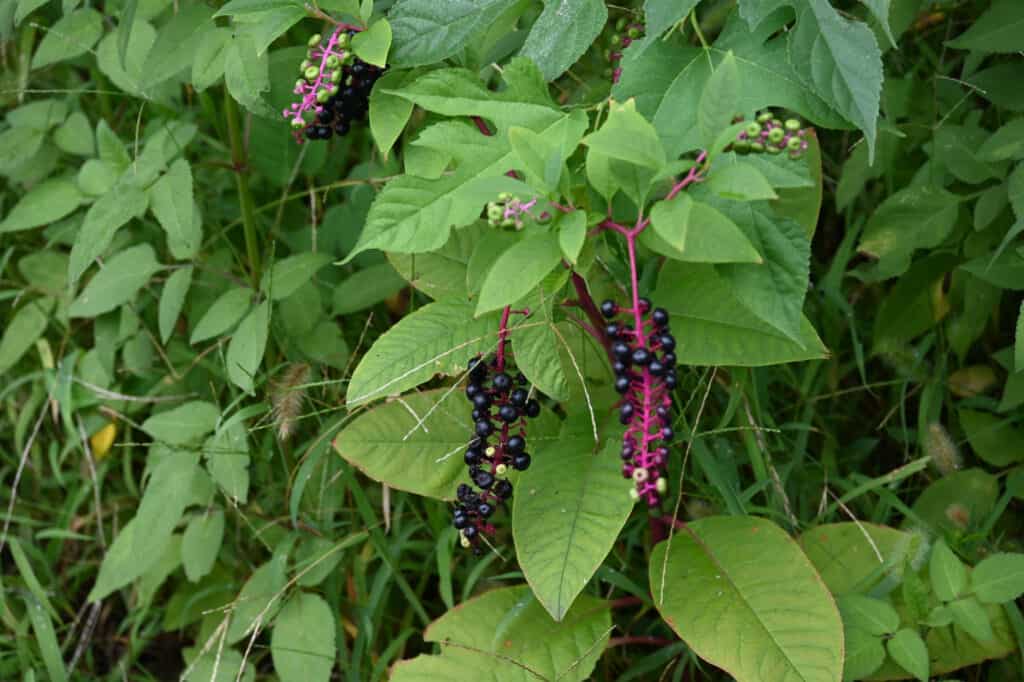
Eating any part of the American pokeweed plant could cause difficulty breathing, convulsions, and unconsciousness.
©tamu1500/Shutterstock.com
6. Water Hemlock (Cicuta maculata)
One of the most poisonous plants in Mississippi is water hemlock. This toxic perennial herb features umbrella-shaped white flower clusters above its purple-spotted stems. The rootstalk of the water hemlock plant stores a highly poisonous liquid in its tiny inner chambers.
Water hemlock grows in the wet soil around marshes, riverbanks, ponds, and streams.
Toxins and Poisoning Symptoms
Circutoxin is the main chemical that makes water hemlock a very dangerous plant. Do not touch or eat any part of water hemlock plants. Touching this toxic plant could cause skin inflammation and a rash. Ingesting water hemlock could result in nausea, vomiting, excessive salivation, convulsions, seizures, respiratory failure, and death.
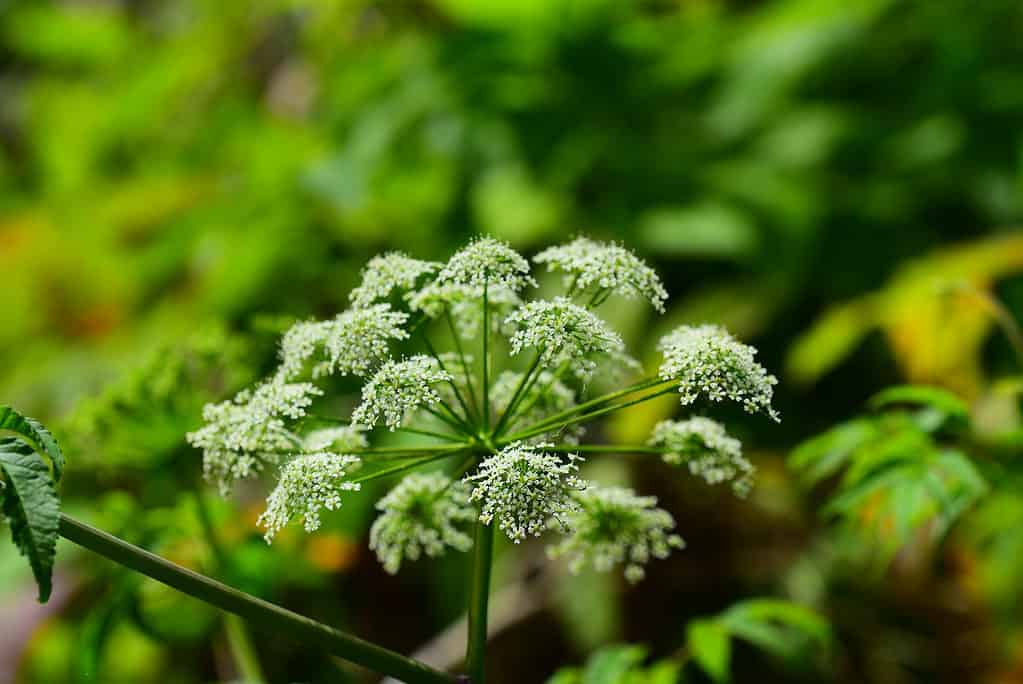
The rootstalk of water hemlock plants stores toxic liquid in tiny chambers.
©iStock.com/cturtletrax
7. Jimsonweed (Datura stramonium)
The jimsonweed is a bushy and freely branching annual plant. It produces beautiful trumpet-shaped white and purple flowers but also has an undesirable smell. That foul odor gets stronger when any of the jimsonweed’s large, lobed leaves are crushed or opened.
Jimsonweed often grows in waste sites, agricultural lands, and other disturbed areas. And this poisonous plant in Mississippi is a heavy self-seeder. So don’t be surprised if you find it growing where it doesn’t belong.
Toxins and Poisoning Symptoms
Jimsonweed produces psychoactive compounds that include hyoscyamine, scopolamine, and atropine. These tropane alkaloids can cause dilated pupils, hallucinations, and rapid heartbeat. Severe symptoms of jimsonweed poisoning include convulsions, delirium, coma, seizures, and death.
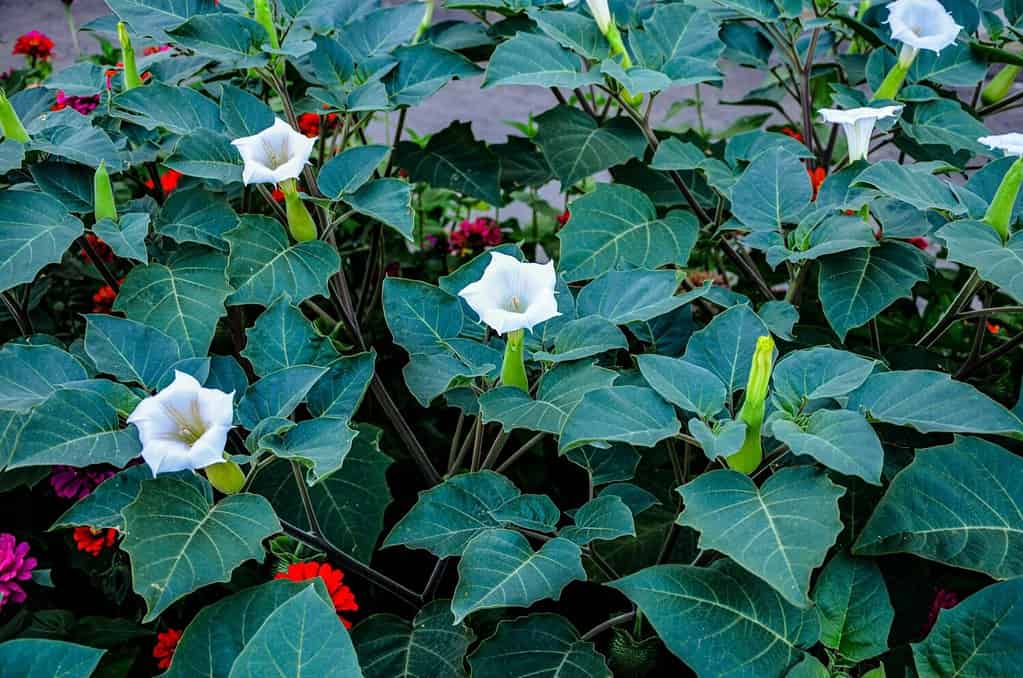
Poisonous jimsonweed plants release a foul odor when their leaves are crushed or otherwise damaged.
©weha/Shutterstock.com
8. Oleander (Nerium oleander)
The oleander is a beautiful ornamental shrub or small tree with slender, lance-shaped leaves and clusters of showy, fragrant flowers. The trumpet-shaped blooms can be in various colors, including pink, red, and white.
Oleander is a desirable showy plant for landscaping, and it grows wild in wet habitats like streambanks and riverbanks. However, this plant is incredibly toxic to humans and animals if ingested.
Toxins and Poisoning Symptoms
Unfortunately, oleander is one of the most poisonous plants in Mississippi because of the cardiac glycosides it produces. Poisoning cases are rare, but ingesting any parts of this plant could be deadly. The common symptoms of plant poisoning from eating oleander are nausea, vomiting, blurred vision, an irregular heartbeat, confusion, seizures, and possibly death. Touching oleander plants could also lead to a red and uncomfortable skin rash.

The oleander shrub is a showy ornamental with highly poisonous toxins inside.
©Happy window/Shutterstock.com
Don’t let poisonous plants in Mississippi ruin your outdoor fun.
The Magnolia State is home to many intriguing plants, including incredibly toxic ones. So enjoy your outdoor adventures among the poisonous plants in Mississippi with care. The easiest way to stay safe on Mississippi camping trips and nature hikes is to become familiar with the local toxic plants before venturing out. Then avoid going near plants that aren’t familiar to you. A little education and caution go a long way toward keeping the poisonous plants in Mississippi from turning your outdoor fun into an emergency.
The photo featured at the top of this post is © iStock.com/Katrin_Timoff
Thank you for reading! Have some feedback for us? Contact the AZ Animals editorial team.







